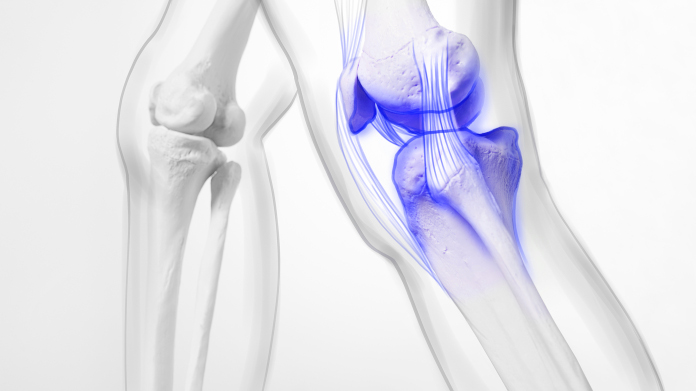Joint problems: which is the best dietary supplement to take?
With close to 400 joints, the human body enjoys excellent mobility. But when these joints become ‘rusty’, it stops us in our tracks. Here are some tips on choosing the right dietary supplement to help with joint discomfort.

Reminder: what causes joint problems?
A joint is a kind of ‘hyphen’ between two neighbouring bones. Put simply, it consists of ligaments, connecting bony structures, and cartilage, soft tissue lining the ends of bones to protect them against friction. In the body’s most-used joints, cartilage is lubricated by a viscous liquid called synovial fluid.
When they function properly, joints ensure suppleness and fluidity of movement. This is normally a well-oiled machine, but it can malfunction, manifesting in joint discomfort.
Less commonly related to inflammation or infection, such discomfort can sometimes occur after an injury or overly strenuous exercise. But when the problem becomes established, it can cause a significant level of discomfort that interferes with daily activities (walking, or even chewing).
As the aging process produces changes to the cartilage cushioning the joints we use the most (such as the knees, hips and ankles), advancing age is unsurprisingly a key predisposing factor (1). Other factors, such as excess weight or regular high-level physical activity, can also increase the pressure on certain joints (2-3).
The good news is that by adopting the following simple steps, you can give your joints some serious TLC:
- maintain your musculoskeletal system by avoiding a sedentary lifestyle (engaging in non-weight bearing, aqua-aerobic type exercise is ideal as it does not put pressure on the joints) (4);
- if you’re overweight, lose a few pounds to lighten the load on your joints;
- perform a series of gentle stretches when you get up every morning to gradually loosen up your joints;
- make sureyou have good quality bedding (pillow, bed base, mattress) to provide optimal support.
Natural bamboo extract for joint health
Does nature offer any solutions to our joint problems? To the best of our knowledge, bamboo (Bambusa vulgaris), a plant with woody stems growing to 10 meters or more, remains the best natural substance for supporting the joints. Used for thousands of years in traditional Chinese and Indian medicine, this evergreen grass is good for both joint and bone health.
It is therefore included in various joint-specific synergistic supplements (such as Joint Support Formula, also rich in marine-origin chondroitin sulfate and glucosamine sulfate) (5).
Boswellia serrata resin for fighting joint discomfort
Known as ‘Salai Guggul’ in Ayurvedic medicine, boswellia (Boswellia serrata) is a tree native to Africa and the Middle East. It grows primarily in tropical Africa and the southern Arabian peninsula.
When the trunk is tapped, the bark produces an oleo gum resin known as incense or olibanum, which used to be consumed at funeral ceremonies to purify the soul. Its benefits for joint health were quickly identified and documented, particularly in Ayurvedic texts.
Containing high concentrations of two boswellic acids (KBA et AKBA), Boswellia serrata resin is recognized for supporting joint health (6). This excellent natural resource therefore features as a key ingredient in certain dietary supplements (such as Super Boswellia, a state-of-the-art Boswellia serrata supplement). You can also complement oral supplementation by applying a boswellia-based cream to a painful joint (such as Smart Joints, also rich in eucalyptus).
Hyaluronic acid, a star performer when it comes to joints
Naturally present in skin, hyaluronic acid has primarily been in the spotlight as a result of its use in cosmetic procedures. But it’s not just for filling in wrinkles! This molecule is what gives synovial fluid its viscosity and it is therefore popular with those looking to improve the condition and comfort of their joints (7).
To obtain its benefits, you can take a hyaluronic acid supplement (such as the product Hyaluronic Acid, a unique formulation containing high-molecular weight molecules). Or you could even opt for a special ‘joint combo’ (such as the supplement Flexi Smart, which combines hyaluronic acid and boswellia as well as avocado and soybean unsaponifiables).
Supplementation with marine-source collagen
Connective tissue is present in blood vessels, organs and bones, and plays a key role in supporting and protecting other tissues in the body. Articular and periarticular structures are no exception: they are composed of fibrous connective tissue which is particularly rich in collagen.
Unfortunately, collagen production tends to decline with age, leading to deterioration of the skin and joints. As a result, some people choose to take a marine-source collagen supplement (such as Marine Collagen, containing patented collagen obtained from high quality raw materials) (8).
References
- Shane Anderson A, Loeser RF. Why is osteoarthritis an age-related disease?. Best Pract Res Clin Rheumatol. 2010;24(1):15-26. doi:10.1016/j.berh.2009.08.006
- King LK, March L, Anandacoomarasamy A. Obesity & osteoarthritis. Indian J Med Res. 2013;138(2):185-193.
- Patel DR, Villalobos A. Evaluation and management of knee pain in young athletes: overuse injuries of the knee. Transl Pediatr. 2017;6(3):190-198. doi:10.21037/tp.2017.04.05
- Kutzner I, Richter A, Gordt K, et al. Does aquatic exercise reduce hip and knee joint loading? In vivo load measurements with instrumented implants. PLoS One. 2017;12(3):e0171972. Published 2017 Mar 20. doi:10.1371/journal.pone.0171972
- The clinical effectiveness of glucosamine and chondroitin supplements in slowing or arresting progression of osteoarthritis of the knee: a systematic review and economic evaluation. Black C, Clar C, Henderson R et al. Health Technol Assess. 2009 Nov;13(52):1-148. Review.
- Yu G, Xiang W, Zhang T, Zeng L, Yang K, Li J. Effectiveness of Boswellia and Boswellia extract for osteoarthritis patients: a systematic review and meta-analysis. BMC Complement Med Ther. 2020;20(1):225. Published 2020 Jul 17. doi:10.1186/s12906-020-02985-6
- Bowman S, Awad ME, Hamrick MW, Hunter M, Fulzele S. Recent advances in hyaluronic acid based therapy for osteoarthritis. Clin Transl Med. 2018;7(1):6. Published 2018 Feb 16. doi:10.1186/s40169-017-0180-3
- Bourdon B, Contentin R, Cassé F, et al. Marine Collagen Hydrolysates Downregulate the Synthesis of Pro-Catabolic and Pro-Inflammatory Markers of Osteoarthritis and Favor Collagen Production and Metabolic Activity in Equine Articular Chondrocyte Organoids. Int J Mol Sci. 2021;22(2):580. Published 2021 Jan 8. doi:10.3390/ijms22020580
Keywords
7 Days
A Product worth waiting for when not…
A Product worth waiting for when not available and then arriving as a surprise!
DOMINIC
8 Days
On time shipping
On time shipping
GEORGE Verne
10 Days
Ordering was easy and the product was…
Ordering was easy and the product was delivered with no problems. Appreciated that I was notified when it would arrive. Thanks!
MascarC
16 Days
Great customer service - responsive …
I ordered from them and my item was unavailable for sometime. I was super happy when they reactivated my order and shipped my item which arrived very quickly. Great customer service.
Ruth Rueter
17 Days
Super fast shipping
Super fast shipping
Donald Borling
20 Days
Reputable companysearch and the number of…
The research and the number of selection of products.
NAKHJAVAN Shervin
33 Days
The Anti Aromatase is a great product
The Anti Aromatase is a great product. You just need to have constant inventory. Recently this product has been out of stock.
GEORGE Verne
34 Days
Great help on chat
Great help on chat. Knowledgeable and friendly.
Jason Argos
38 Days
Customer service was fast and friendly.
Customer service helped to stop the transaction process of the subscription. I appreciated that.
Greenie
38 Days
I order here due to the high quality of…
I order here due to the high quality of the products and the quick delivery of items - thank you
Barbara J
40 Days
SuperSmart's Eye Pressure supplements: highly recommended!
I purchase SuperSmart's Eye Pressure supplements regularly for over 5 years, and gotta say they are truly a wonderful product for my Glaucoma. Highly recommended if you have eye pain from your Glaucoma.
D. Martinez
44 Days
Quick service
Quick service
MONELL
45 Days
Speedy service.
Speedy service.
ROSENTHAL Marvin
48 Days
Clear website- Efficient
Clear website. Excellent search engine and fast delivery!
Mohamad Hussein
51 Days
They have great products.
They have great products.
Vickie



